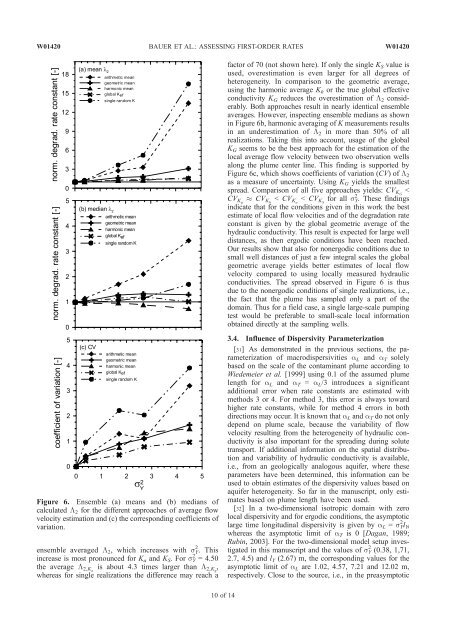Applied numerical modeling of saturated / unsaturated flow and ...
Applied numerical modeling of saturated / unsaturated flow and ...
Applied numerical modeling of saturated / unsaturated flow and ...
Create successful ePaper yourself
Turn your PDF publications into a flip-book with our unique Google optimized e-Paper software.
W01420 BAUER ET AL.: ASSESSING FIRST-ORDER RATES W01420<br />
Figure 6. Ensemble (a) means <strong>and</strong> (b) medians <strong>of</strong><br />
calculated L 2 for the different approaches <strong>of</strong> average <strong>flow</strong><br />
velocity estimation <strong>and</strong> (c) the corresponding coefficients <strong>of</strong><br />
variation.<br />
ensemble averaged L2, which increases with sY 2 . This<br />
increase is most pronounced for Ka <strong>and</strong> KS. For sY 2 = 4.50<br />
the average L2,K a is about 4.3 times larger than L2,K g ,<br />
whereas for single realizations the difference may reach a<br />
10 <strong>of</strong> 14<br />
factor <strong>of</strong> 70 (not shown here). If only the single KS value is<br />
used, overestimation is even larger for all degrees <strong>of</strong><br />
heterogeneity. In comparison to the geometric average,<br />
using the harmonic average Kh or the true global effective<br />
conductivity KG reduces the overestimation <strong>of</strong> L2 considerably.<br />
Both approaches result in nearly identical ensemble<br />
averages. However, inspecting ensemble medians as shown<br />
in Figure 6b, harmonic averaging <strong>of</strong> K measurements results<br />
in an underestimation <strong>of</strong> L2 in more than 50% <strong>of</strong> all<br />
realizations. Taking this into account, usage <strong>of</strong> the global<br />
KG seems to be the best approach for the estimation <strong>of</strong> the<br />
local average <strong>flow</strong> velocity between two observation wells<br />
along the plume center line. This finding is supported by<br />
Figure 6c, which shows coefficients <strong>of</strong> variation (CV) <strong>of</strong>L2<br />
as a measure <strong>of</strong> uncertainty. Using KG yields the smallest<br />
spread. Comparison <strong>of</strong> all five approaches yields: CVK G <<br />
CVK g CVK h < CVK a < CVK S for all sY 2 . These findings<br />
indicate that for the conditions given in this work the best<br />
estimate <strong>of</strong> local <strong>flow</strong> velocities <strong>and</strong> <strong>of</strong> the degradation rate<br />
constant is given by the global geometric average <strong>of</strong> the<br />
hydraulic conductivity. This result is expected for large well<br />
distances, as then ergodic conditions have been reached.<br />
Our results show that also for nonergodic conditions due to<br />
small well distances <strong>of</strong> just a few integral scales the global<br />
geometric average yields better estimates <strong>of</strong> local <strong>flow</strong><br />
velocity compared to using locally measured hydraulic<br />
conductivities. The spread observed in Figure 6 is thus<br />
due to the nonergodic conditions <strong>of</strong> single realizations, i.e.,<br />
the fact that the plume has sampled only a part <strong>of</strong> the<br />
domain. Thus for a field case, a single large-scale pumping<br />
test would be preferable to small-scale local information<br />
obtained directly at the sampling wells.<br />
3.4. Influence <strong>of</strong> Dispersivity Parameterization<br />
[31] As demonstrated in the previous sections, the parameterization<br />
<strong>of</strong> macrodispersivities a L <strong>and</strong> a T solely<br />
based on the scale <strong>of</strong> the contaminant plume according to<br />
Wiedemeier et al. [1999] using 0.1 <strong>of</strong> the assumed plume<br />
length for a L <strong>and</strong> a T = a L/3 introduces a significant<br />
additional error when rate constants are estimated with<br />
methods 3 or 4. For method 3, this error is always toward<br />
higher rate constants, while for method 4 errors in both<br />
directions may occur. It is known that aL <strong>and</strong> aT do not only<br />
depend on plume scale, because the variability <strong>of</strong> <strong>flow</strong><br />
velocity resulting from the heterogeneity <strong>of</strong> hydraulic conductivity<br />
is also important for the spreading during solute<br />
transport. If additional information on the spatial distribution<br />
<strong>and</strong> variability <strong>of</strong> hydraulic conductivity is available,<br />
i.e., from an geologically analogous aquifer, where these<br />
parameters have been determined, this information can be<br />
used to obtain estimates <strong>of</strong> the dispersivity values based on<br />
aquifer heterogeneity. So far in the manuscript, only estimates<br />
based on plume length have been used.<br />
[32] In a two-dimensional isotropic domain with zero<br />
local dispersivity <strong>and</strong> for ergodic conditions, the asymptotic<br />
large time longitudinal dispersivity is given by aL = sY 2 lY,<br />
whereas the asymptotic limit <strong>of</strong> aT is 0 [Dagan, 1989;<br />
Rubin, 2003]. For the two-dimensional model setup investigated<br />
in this manuscript <strong>and</strong> the values <strong>of</strong> sY 2 (0.38, 1,71,<br />
2.7, 4.5) <strong>and</strong> lY (2.67) m, the corresponding values for the<br />
asymptotic limit <strong>of</strong> aL are 1.02, 4.57, 7.21 <strong>and</strong> 12.02 m,<br />
respectively. Close to the source, i.e., in the preasymptotic

















